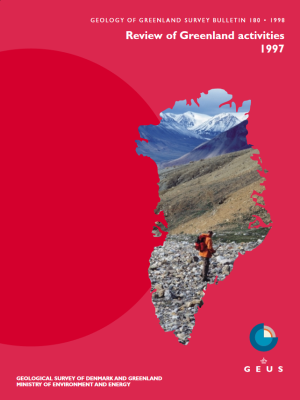New structure maps over the Nuussuaq Basin, central West Greenland
DOI:
https://doi.org/10.34194/ggub.v180.5081Abstract
In 1992 the Geological Survey of Greenland (GGU) discovered bitumen in vugs and vesicles in Upper Paleocene basalts in western Nuussuaq (Christiansen et al. 1994). Since then the search for surface oil showings by GGU (from 1995 by the Geological Survey of Denmark and Greenland, GEUS) has resulted in finds over an area extending from northern Disko through Nuussuaq to the south-east corner of Svartenhuk Halvø (Christiansen et al. 1997, 1998, this volume). In addition, slim core drilling by GGU and grønArctic Energy Inc., the holder of an exclusive licence in western Nuussuaq, penetrated oil-saturated rocks at four localities (Christiansen et al. 1996). Encouraged by these results, grønArctic drilled a conventional exploration well (GRO#3) to 2996 m in 1996 (Christiansen et al. 1997), but details about this have not been released. The net effect of these efforts has been to dispel partially the formerly widespread view that the West Greenland area is entirely gas-prone and to promote the Cretaceous– Tertiary Nuussuaq Basin from being a model for what may occur in offshore basins to being a potential petroleum basin in its own right. Evolving conceptions of the Nuussuaq Basin took a large step forward when GGU in 1994 acquired a 13 km 15-fold seismic line on the south coast of Nuussuaq (Christiansen et al. 1995). This showed a sedimentary section 6–8 km thick, much greater than the 2–3 km previously measured from onshore outcrops alone. This showed how little was understood about the structure of the basin, as well as where hydrocarbons might have been generated and where exploration could best be directed. A first step to rectify this situation was taken in 1995 when multichannel seismic and gravity data were acquired by the Survey in Disko Bugt and the fjords north and south of Nuussuaq, as well as west of Disko (Christiansen et al. 1996). The new data have been integrated with older gravity, magnetic and seismic data from both onshore and offshore. This report summarises the results of interpretation of all available geophysical data together with a reappraisal of all available data on faults onshore. Detailed accounts are being published elsewhere (Chalmers 1998; J.A. Chalmers et al. unpublished data). Although the open spacing of the seismic lines and the almost total lack of reflections below the first sea-bed multiple on these lines make it impossible to present a definitive structural model at this stage, the structural style in the basin is now apparent and a number of the major structures in the area have been identified with confidence.
Downloads
Published
Issue
Section
License
This article is distributed under a CC-BY 4.0 licence, permitting free redistribution and reproduction for any purpose, even commercial, provided proper citation of the original work. Author(s) retain copyright over the article contents.


